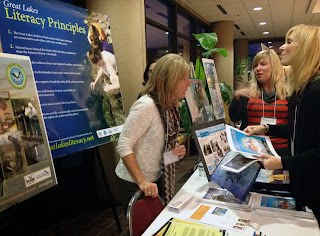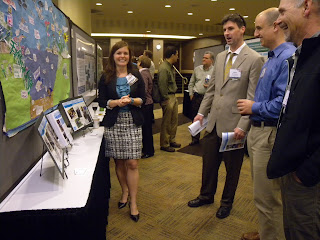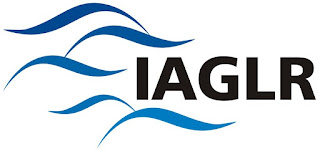November 24th, 2014 by iisg_superadmin
Several IISG staff members were in Grand Rapids, MI earlier this month to share some of our education resources and curricula during the Great Lakes Place-based Education Conference. For Allison Neubauer, the experience had an unexpected twist.
Stewardship and place-based education are nothing new to us educators at Illinois-Indiana Sea Grant. In fact, the IISG education team has been leading efforts in these initiatives throughout southern Lake Michigan communities for years. For this reason, going into the conference, I thought it was a great opportunity for us to share our models of stewardship and place-based education. I didn’t plan on gaining much insight into how and why these objectives were critical. Boy, was I wrong.
IISG undoubtedly has an arsenal of exemplary stewardship models, and a jam-packed room of eager educators at our Friday afternoon session was an indication of their desire to hear how we’ve extended learning beyond classrooms and into communities.
But as much as I enjoyed sharing our examples of student stewardship as a means of combatting invasive species, promoting proper disposal of unwanted medication, and teaching about benefits and risks of fish consumption, the best part of the conference was actually hearing others share their stories.
The opening keynote address by Kim Rowland, a middle school science teacher, detailed how her students have been able to use their surrounding environment in Grand Rapids as a resource for exploration and learning. What was most captivating and exciting to hear was how this time spent investigating the outdoors was a way to reach students that are not typically high academic achievers. Kim told us about a particular student who was always getting in trouble—not wanting to come to school, and certainly not excited about learning. Though she had not anticipated this, venturing out to the stream on school property transformed him into the most enthusiastic student of the group. In fact, this student was now so interested in collecting samples that he waded even further into the stream, thus giving Kim a very fitting title for her presentation: “Getting Your Feet Wet and Allowing Water to Flood Your Boots.”
This was a great way to kick-off the conference. It really impressed upon me that place-based education should not be considered a luxury, or something that only all-star teachers are doing. Every student—from urban to rural, high achieving to special needs—must be exposed to learning outside the classroom. School should not take place in isolation, between the same four walls everyday. There is immense value in connecting students with their communities and surrounding environments as a means to enhance learning and civic understanding.
November 15th, 2013 by Irene Miles
The 3rd Annual Great Lakes Place-based Education Conference, November 7-9 in Grand Rapids, Michigan, brought together over 200 teachers, community representatives, non-profit organization educators, and more. The conference gives teachers an opportunity to incorporate the latest place-based research and education concepts about the Great Lakes into their lessons, encouraging student stewardship, continuing science education, and community development.
 IISG’s Robin Goettel attended the conference and organized a poster session, “Center for Great Lakes Literacy: Connecting Educators, Scientists and Citizens.” The Center for Great Lakes Literacy (CGLL) “engages educators, students, scientists, and lifelong learners in stewardship and citizen science activities to help protect and restore Great Lakes watersheds.”
IISG’s Robin Goettel attended the conference and organized a poster session, “Center for Great Lakes Literacy: Connecting Educators, Scientists and Citizens.” The Center for Great Lakes Literacy (CGLL) “engages educators, students, scientists, and lifelong learners in stewardship and citizen science activities to help protect and restore Great Lakes watersheds.”
According to Robin, “A major focus of this exhibit was creating awareness of Great Lakes Literacy Principles – a great foundation from which to create an environmental stewardship ethic. CGLL specialists shared exciting educator opportunities including ship-based and shoreline workshops focusing on the latest Great Lakes issues. Visitors learned about water quality monitoring equipment they can use with their students made available courtesy of the USEPA GLNPO Limno Loan program. Participants also found out about Great Lakes Awareness Days that will be offered throughout the region.”
 Representatives of the CGLL program from seven Great Lakes Sea Grant programs were on hand to talk with attendees about the wide array of resources available, many specifically tailored to the environmental needs and issues of their region. Classroom resources were also available, including Fresh and Salt and Greatest of the Great Lakes curricula, as well as the Dose of Reality newspaper activity guide that covers the disposal of unwanted medicines and personal care products.
Representatives of the CGLL program from seven Great Lakes Sea Grant programs were on hand to talk with attendees about the wide array of resources available, many specifically tailored to the environmental needs and issues of their region. Classroom resources were also available, including Fresh and Salt and Greatest of the Great Lakes curricula, as well as the Dose of Reality newspaper activity guide that covers the disposal of unwanted medicines and personal care products.
June 10th, 2013 by Irene Miles
Three of IISG’s interns were among the hundreds of scientists, researchers, educators, and more in attendance at last week’s IAGLR 2013 conference. Each of them wrote in to tell us more about their experiences at the conference, and some interesting things they took away from the sessions.
Emily Anderson, interning with IISG’s environmental social scientist Caitie McCoy, learned more about the major issues facing the Great Lakes:
“During the week I spent at the IAGLR conference I gained a greater understanding of how researchers, policy makers, and citizens alike have to be included in the conversation for the Great Lakes to be restored, conserved, and used sustainably. Through the talks I attended I learned a lot about how harmful algal blooms, personal medications, and impermeable surfaces can affect the health of the Great Lakes, but what I found most interesting was witnessing the cooperative efforts between the United States and Canada. I found it so encouraging to watch as representatives from the two countries shared data and other resources to face the challenges affecting the health of the Great Lakes region jointly. The IAGLR conference was a magical experience for me; I saw with my own two eyes the genesis of future policy and research. Most importantly for my position as an IISG intern, I now understand where Sea Grant fits into the equation of Great Lakes protection with research, education, and outreach.”
Allison Neubauer, a Great Lakes education intern working with IISG’s Kristin TePas, was aware of a number of environmental issues, but was still surprised to learn about the wide range of current and potential problems facing the Great Lakes:
“The greatest take-away from my week at IAGLR would have to be the myriad issues affecting the Great Lakes, and the critical importance of continued research and education to addressing them. In spite of my general understanding of environmental science and the Great Lakes, I was woefully under-informed about the more-than-50 different issues that had entire sessions devoted to them.
For this reason, my favorite part was sitting in on the educator-scientist roundtable discussion. The goal was to bring real issues into the classroom with place-based learning. Teachers and researchers alike proposed many exciting ideas for incorporating Great Lakes research into science lessons. It was awesome to see how enthusiastic educators were about collaborating with scientists and going the extra mile to make science more relevant and fun for students. In my mind this was the most important facet of the IAGLR conference because students need to be exposed to real, current issues surrounding them and affecting the vital resources of the Great Lakes. I think this collaborative effort could spark career-building education for future scientists and very possibly inspire them to be Great Lakes researchers giving their own talks at an IAGLR conference years from now.”
Cait Lackey, who will be working with Greg Hitzroth and the IISG aquatic invasive species team, was excited to learn more about the many areas where Sea Grant works to help protect and preserve the Great Lakes:
“Prior to the IAGLR conference my knowledge about the Great Lakes was limited. At the conference I learned that there are a multitude of issues facing the Great Lakes, many of which I wasn’t familiar with. Some of my favorites included the effects that the Great Lakes have on tourism, marketing strategies for invasive species in the Great Lakes, and the use of landscape architecture for restoration ecology.
At IAGLR I also learned about the various roles Sea Grant plays in protecting the health of the Great Lakes. Just from meeting other Sea Grant employees and interns and hearing some of their presentations, I learned that the Sea Grant staff works to educate many people and audiences including teachers, students, fisherman, local residents, and retailers. I also learned that Sea Grant staff works to research and present solutions to problems the Great Lakes currently face. I had the opportunity to see presentations given by Sea Grant Staff that involved a great deal of research and development, and attending the IAGLR conference showed me that the work Sea Grant participates in is detailed, diverse, and at times very challenging.”
Find out more about IAGLR and the annual conference at the link above, and follow IAGLR on Twitter as well.
May 15th, 2013 by Irene Miles
IISG’s Laura Kammin will co-chair a two-part session on the impacts and management of contaminants at this year’s Conference on Great Lakes Research, June 2-6 at Purdue University. Researchers will present on a range of issues, including contaminant testing, impacts to wildlife, and pollution trends over time. With 24 presentations spread over two days from researchers, resource managers, and industry representatives, it will be the conference’s largest session.
Presentations begin on June 5 with new research on pollutants that are a longstanding problem in the Great Lakes region, including PCBs, mercury, and chemicals used in driveway sealants. Research on these legacy contaminants will focus on their concentrations, dispersal, and environmental impacts in the years after federal regulations barred their use.
Day two of the session is dedicated to emerging contaminants, which have more recently been detected in the Great Lakes. Among the presentations is a study that found flame retardant in the eggs of herring gulls exposed to the pollutant. Other presentations will introduce techniques for identifying new contaminants, the impacts of pharmaceutical hormones on fish, and changes in bacterial communities caused by a common nanomaterial.
“The sheer number of contaminants and breadth of potential impacts makes sessions like these very important,” said Kammin, IISG pollution prevention program specialist. “To truly improve the health of the lakes, we must have a better understanding of these legacy and emerging contaminants.”
 Additional session co-chairs include Marta Venier, Maria Sepulveda, and Bernard Crimmins.
Additional session co-chairs include Marta Venier, Maria Sepulveda, and Bernard Crimmins.
Prior to the session, 15 researchers and students will also present findings related to legacy and emerging contaminants during the conference poster session on June 4.
The International Association for Great Lakes Research’s (IAGLR) 56th Annual Conference on Great Lakes Research is sponsored by IISG and Purdue University. The four-day program includes research sessions, panel discussions, keynote speakers, and workshops on a variety of topics. To view the entire program, visit the conference website.
February 18th, 2013 by Irene Miles
 IISG’s Caitie McCoy attended the Seventh International Conference on Remediation of Contaminated Sediments last week to present her community outreach work with the Great Lakes Legacy Act (GLLA). The conference traditionally features environmental scientists and engineers, but that is changing. “We are starting to see more attention paid to community engagement at these types of conferences,” Caitie tells us. “Technical project managers realize that projects are easier to implement when the community understands and supports the work, and so they’re eager to learn from professionals who specialize in community engagement and stakeholder involvement.”
IISG’s Caitie McCoy attended the Seventh International Conference on Remediation of Contaminated Sediments last week to present her community outreach work with the Great Lakes Legacy Act (GLLA). The conference traditionally features environmental scientists and engineers, but that is changing. “We are starting to see more attention paid to community engagement at these types of conferences,” Caitie tells us. “Technical project managers realize that projects are easier to implement when the community understands and supports the work, and so they’re eager to learn from professionals who specialize in community engagement and stakeholder involvement.”
Caitie presented a poster on her educational program in northwest Indiana, which taught students about the GLLA sediment cleanup at Roxana Marsh on the Grand Calumet River. Instead of presenting a typical scientific poster full of text and graphs, Caitie displayed a mural that her fourth grade students made to represent the Roxana Marsh ecosystem.
“Some of my colleagues were a bit skeptical about me presenting a fourth grade mural to a bunch of technical folks, but I’m not afraid to shake things up,” Caitie said. “I wanted to use something eye-catching that would draw people’s attention toward my poster.” And it worked. Caitie was visited non-stop during the session and talked to more than 100 conference attendees about her program. When asked if she thought her poster made an impact, Caitie replied, “I would never have dreamed that someday engineers would be asking me how to replicate my educational program at their sites, so I take that as a big success.”
 Caitie will expand her programming throughout the Grand Calumet River community in 2013, as the Legacy program begins another phase of dredging this summer.
Caitie will expand her programming throughout the Grand Calumet River community in 2013, as the Legacy program begins another phase of dredging this summer.







